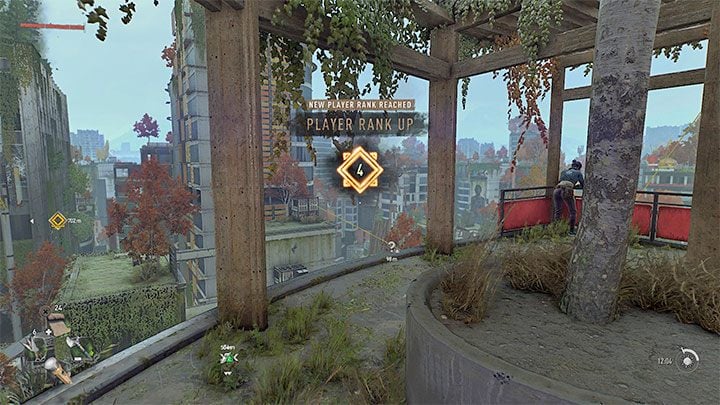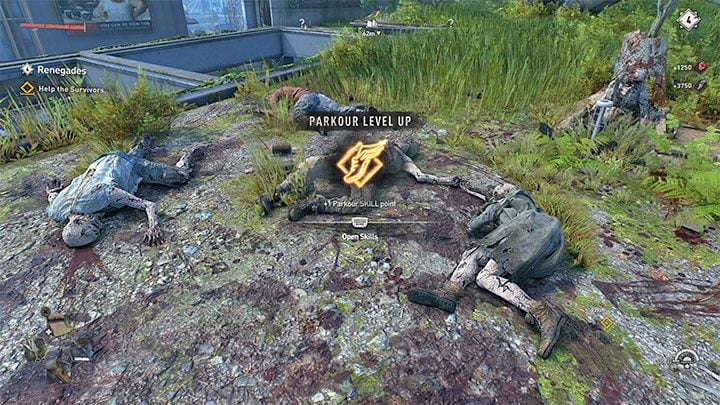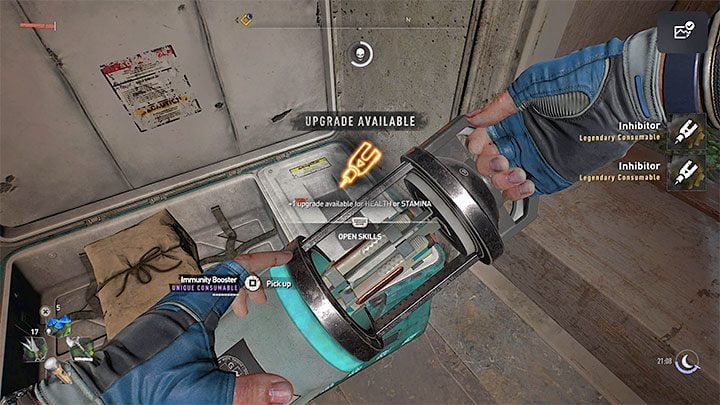Dying Light 2: Leveling up
This Dying Light 2 guide page tells you about character development - you will learn about player rank, XP, skills, stats and equipment.
This page of the Dying Light 2 guide is dedicated to character development. Among others, we explain how to advance to new levels and improve your skills and statistics. The following tips broach subjects such as player level, accumulating XP, unlocking new skills, increasing health and stamina, as well as finding and equipping better and better equipment.
- Player rank
- Proficiencies - combat and parkour
- Skills
- Health, stamina and immunity
- Weapons and modifications for them
- Equipment and unique bonuses offered by it
Player rank

The player's rank can be explained as your current experience level and the way of determining the current power level of your hero. During the game, you'll only get promoted a few times, but attaining each new level is a very important event. You can increase your rank by earning and spending skill points in Combat and Parkour categories (more on this in the next section).
Experience level affects:
- The difficulty of the further challenges - each district and encountered enemy is characterized by rank. You should avoid entering districts and fighting enemies of higher ranks, as otherwise, you may not be able to withstand the challenge and quickly die. Look for activities and fights with a rank equal to or lower than the protagonist's current rank.
- Level of found or bought equipment - leveling your character unlocks items of higher ranks, either bought, obtained or received. Higher-level items have better statistics, resulting in e.g. more damage dealt by your hero or more armor. This is mostly evident when visiting traders or craftsmasters - e.g. you won't be able to buy level 3 items if your current level is 1 or 2.
Important note - After you complete the main story and enter the endgame phase, the game will start using the level scaling. This means that the game will begin to scale the difficulty level of fights, quests and activities to Aiden's current rank. This can make it difficult for you to kill enemies and complete quests. We recommend doing the more difficult quests and challenges before completing the main storyline.
Proficiencies - combat and parkour

Experience points earned during the game are distributed in two categories called Proficiencies, where they accumulate, allowing you to attain new levels. These are:
- Combat Proficiency - Combat XP is obtained for successful attacks and killing enemies in various ways.
- Parkour Proficiency - Parkour XP is accumulated by successfully performing parkour moves (jumping, climbing, wall running, etc.)
Each time you accumulate enough XP in a given category, you will receive a combat point or a parkour point - these are spent on Skills. In addition, each time you level up your Proficiency, you will get closer to increasing the player rank, described in the previous fragment.
On a separate page Experience - how to level up quickly?, you can learn more about accumulating XP in both these categories.
Skills

Obtained proficiency points can be spent on new skills. Unfortunately, there are some limitations, as
- Combat proficiency points can only be spent on skills from the Combat tree.
- Parkour proficiency points can only be spent on skills from the Parkour tree.
Moreover, the individual skills may have additional requirements, e.g. a certain amount of health/stamina points (more in the next fragment) or a certain skill unlocked beforehand. The skills you have unlocked can be:
- Active - they have to be activated e.g. by pressing a button or a combination of buttons.
- Passive - once unlocked, they stay turned on, e.g. offering a boost to statistics that works throughout the game.
A list of recommended skills and other vital information regarding statistics and equipment can be found on a dedicated page (Best Build).
Health, stamina and immunity

Health, stamina, and immunity are some of the most important statistics that describe the hero.
- The health affects the amount of available health points. The longer the health bar, the more punishment you can take without dying.
- Stamina affects the number of available stamina points, spent when exerting yourself e.g. when attacking an enemy or parkouring. The longer the stamina bar, the more actions you can perform before the hero needs to rest.
- Immunity affects the time you can spend in the dark, either at nighttime or inside dark rooms without turning into a zombie. We described it in more detail on the page Immunity - how does it work?. The longer the immunity bar, the more time you can spend in the dark.
You can increase your health and stamina temporarily by using boosters. If you're looking to increase these attributes permanently, you need inhibitors, items that can be found when exploring or as mission rewards, but they are definitely rare. You need to choose which one of the two parameters to improve, as a single inhibitor can only upgrade one attribute. When it comes to Immunity, you are covered - simply spending inhibitors on health or stamina increases your immunity permanently.
Weapons and modifications for them

All weapons obtained during the game are described by weapon statistics. The most important ones are:
- Weapon Rank - a general category that measures the overall statistics of a weapon. You should obtain and use weapons that have the highest possible rank. This may require further exploring or reaching a point in the game when better-ranked weapons appear, as traders only have weapons that match Aiden's current level.
- Damage - informs how much damage the weapon deals. In the case of melee weapons, you also get information about the type of damage dealt (e.g. slashing, blunt).
- Durability - informs about the current state of the weapon - each use of a given weapon decreases its durability, up to a point when the weapon is no longer usable. More information can be found on the Repairing weapons - is it possible? page. It is worth mentioning that deceasing durability concerns melee weapons only.
- Additional statistics - there are different types of them, for example the weapon may offer a bonus to damage when against a given type of an opponent, or when Aiden's health is on a certain level. The rarer the quality your item has (e.g. unique), the more stats of this type the weapon may have.
- Modifications - the weapons can be improved by installing modifications, which can be placed in two slots - Tip Socket and Shaft Socket. Blueprints for modifications can be found at craftmasters. Among the available modifications, you can choose those that add new bonuses, such as placing a fire or a poison status on the struck enemy.
Note - remember that you can have only 4 weapons equipped at a given time, but you can carry up to 24 of them in your inventory. A good idea would be to have different weapons equipped so you can use them according to the situation (e.g. inflicting quick slashing or slow blunt damage).
Equipment and unique bonuses offered by it

The hero's inventory has 6 slots for clothing - head, gloves, chest, bracers, pants and shoes. When it comes to clothing, the situation is similar to the one described in the section concerning weapons.
- Each piece of clothing has its own rank and rarity level . Additionally, you can get information on how many armor points are awarded after equipping it.
- An important feature is that the items of clothing are indestructible and you don't have to worry about their durability.
- Each item of clothing comes from a specific set , which can also be called a build. Equiping a complete set offers additional bonuses - you can view them by checking out the item description. For example, a medic outfit can offer a bonus to health regeneration, while a tank outfit may increase the damage dealt by two-handed weapons. You don't have to always wear a complete set, although it may be a good idea if you plan to "build" a hero to correspond with the chosen playstyle.
You are not permitted to copy any image, text or info from this page. This site is not associated with and/or endorsed by the Techland or Techland. All logos and images are copyrighted by their respective owners.
Copyright © 2000 - 2025 Webedia Polska SA for gamepressure.com, unofficial game guides, walkthroughs, secrets, game tips, maps & strategies for top games.
